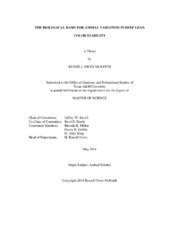| dc.description.abstract | Two experiments were conducted to investigate biochemical factors that
influence beef lean color and beef lean color stability. The first study was conducted to
investigate biochemical traits contributing to lean color and lean color stability in dark
cutting beef. The second study was conducted to evaluate the effects of mitochondrial
functionality during electron transport on beef lean color stability in beef (n = 160).
Beef carcasses exhibiting various levels of dark cutting were selected based on pH:
(severe dark cutter SEDC; mean pH = 6.50, n = 40), moderate dark cutter (MODC;
mean pH = 6.33, n = 40), mild dark cutter (MIDC; mean pH = 6.09, n = 40), shady dark
cutter (SHDC; mean pH = 5.92, n = 40), and normal cohorts (mean pH = 5.53; n = 160)
from the same production lot and similar marbling. For both studies, strip loin
subprimals were aged until 13 d postmortem, when longissimus lumborum steaks were
cut for simulated retail display. Instrumental color attributes [lightness (L*), redness
(a*), yellowness (b*), chroma and hue angle] were determined on d 0, 1, 4, 7, and 11 of
simulated retail display. Overall color change from d 0 was calculated for d 1, 4, 7, and
11 of simulated retail display. Additional steaks were used for determination of electron
loss from the electron transport chain utilizing succinate and glutamate as substrates,
oxygen consumption, nitric oxide metmyoglobin reducing ability, glycolytic potential,
mitochondrial abundance, myoglobin concentration and protein oxidation. The results
from the first experiment suggested that greater electron loss is associated with
decreased metmyoglobin reducing ability and, consequently, reduced beef lean color
stability. The results from the second experiment suggested that dark cutting beef
carcasses favored oxidative metabolism, and overall color stability was greater in dark cutting carcasses than cohort carcasses. Data from these experiments indicate that biochemical factors affect initial lean color attributes, as well as lean color stability attributes. | en |


